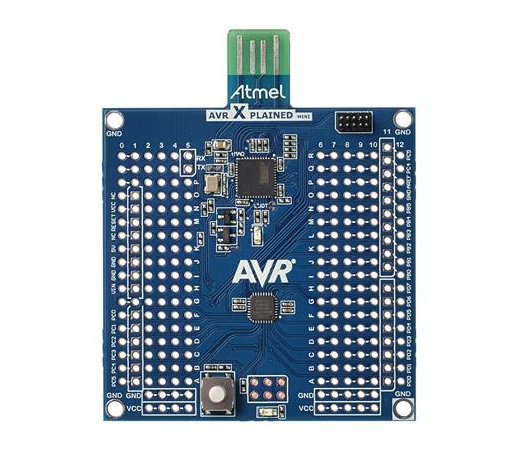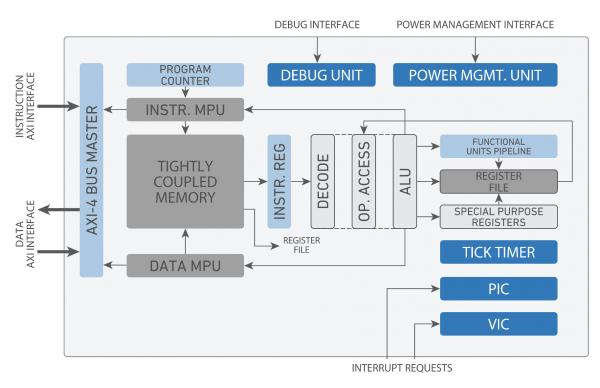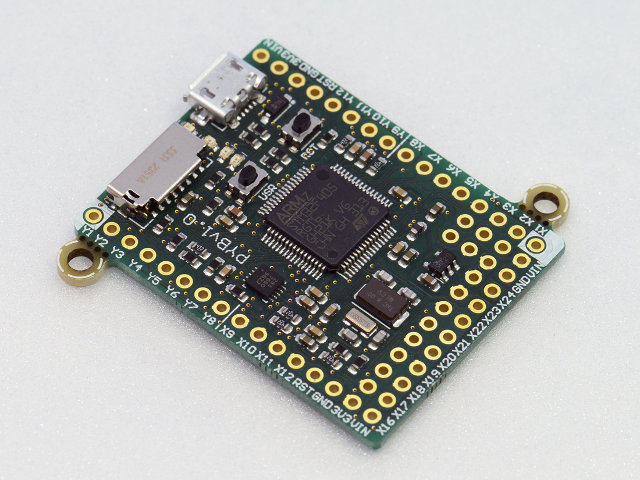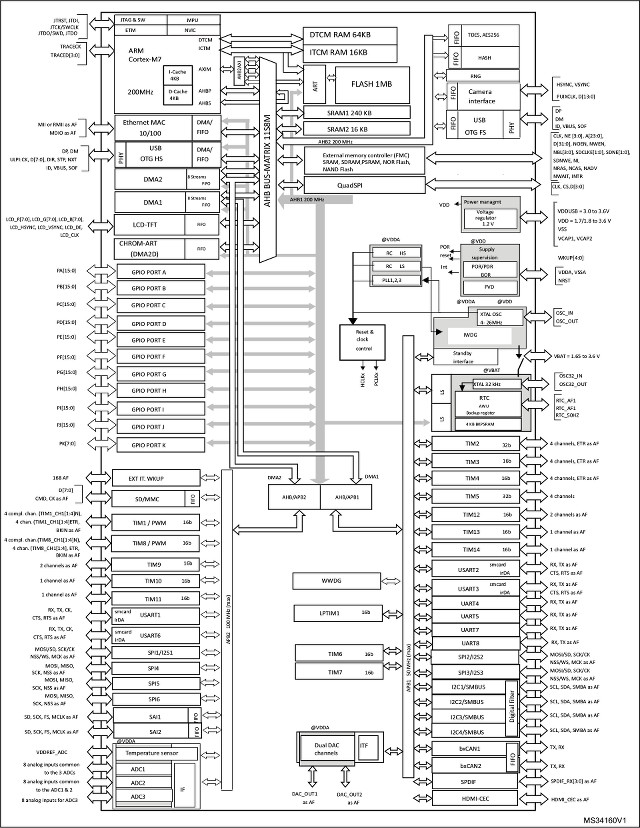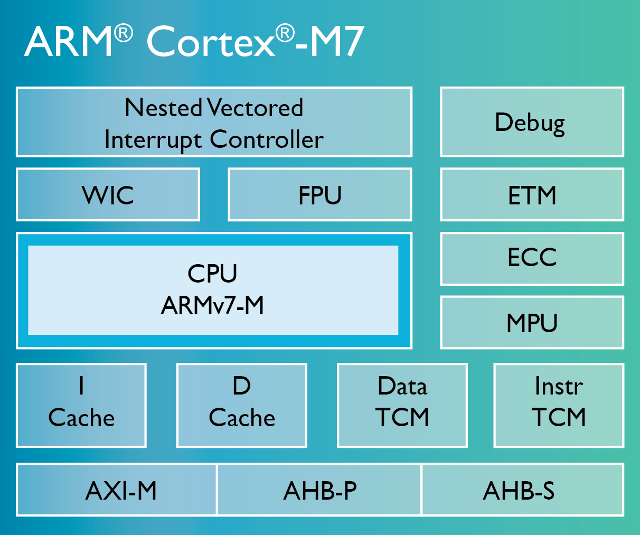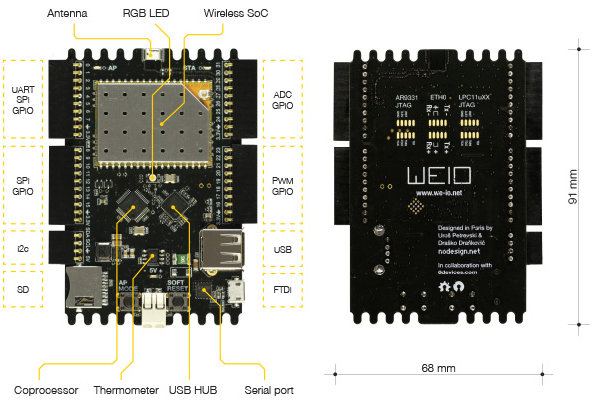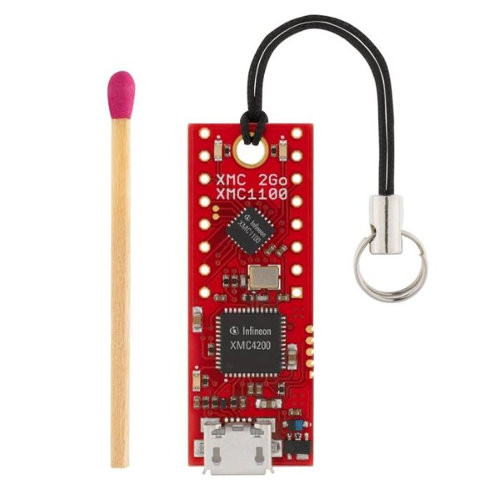Atmel has introduced four new MCU to its megaAVR MCU family with ATmega168PB coming first with 16KB Flash, 512 bytes EEPROM and 1KB RAM, as well as ATmega48PB, ATmega88PB and ATmega328PB to be released in Q1 2015. The new MCUs are pretty similar to the existing mega MCU with an AVR core running at 20MHz, a 10-bit ADC, an Analog Comparator, SPI, I2C, USART, etc…, but they also add a unique serial number readable from application code, the ability to wake-up from power-down mode on receipt of data on the USART interface, and improved accuracy for ADC conversion and UART signals. ATmega328PB also offers a QTouch peripheral touch controller, and on-chip debugging. You can evaluated the new MCU thanks to ATmega168PB Xplained Mini evaluation kit which comes with the following key features: On-board debugger with full source-level debugging support in Atmel Studio Auto-ID for board identification in Atmel Studio 6.2 […]
Beyond Semi Introduces 32-bit BA20 Core with Cortex M4 Performance Efficiency, and Cortex M0+ Silicon Area
Beyond Semiconductor and CAST have jointly announced BA20 32-bit embedded processor core with PipelineZero Architecture (zero-stage execution pipeline), that rivals with ARM Cortex A4 in terms of performance per MHz, while using about the same silicon area as an ARM Cortex M0+. which could be critical for applications such as wearables, sensors, and wireless communication, that may require both a small footprint and high performance efficiency. The company’s PipelineZero micro-archirtecture can execute one instruction per cycle, hence saving energy by doing more in less time, and by operating at lower clock rates. Key features listed for BA20 IP core: PipelineZero architecture for high performance efficiency with tiny silicon footprint 3.04 DMIPs/MHz (vs ARM Cortex M4: 1.25 DMIPS/MHz) 3.41 Coremarks/MHz (vs ARM Cortex M4: 3.40 CoreMarks/MHz) 2µW/MHz (vs ARM Cortex M0+: 3µW/MHz) 10K gates (0.01mm2) in 9-track 40G (vs 0.009mm2 for ARM Cortex M0+) BA2 ISA Extreme Code Density for less […]
Cortus Introduces APS23 and APS25 32-Bit Cores for Micro-controllers
ARM and MIPS are not the only games in town with it comes to 32-bit cores for micro-controllers. I’ve already written about Beyond Semiconductor, and mentioned Andes used in some Wi-Fi SoC, and today I’ve come across another IP company called Cortus. which just introduced APS23 and APS25 cores based on their latest Cortus V2 instruction set. which offers a smaller code footprint compared to there V1 ISA. APS23 can achieve 1.44 Coremarks/MHz, 2.83 DMIPS/MHz, and can run up to 200 MHz when manufactured with 90nm process, whereas APS25 is a bit more powerful with 2.09 Coremarks/MHz, 2.36 DMIPS/MHz, and can run up to 344 MHz. Minimal power consumption is 11.6 and 19.3 uW/Mhz for APS23 and APS25 respectively. Key features of both cores include: APS23 APS25 Excellent Code Density 3 stage pipeline 5-7 Stage Pipeline Sequential Multiplier High Performance Integer Multiply Optional Parallel Multiplier (Gives 2.62 Coremakes/MHz) Integer Divider Full Peripheral Set Dual […]
Pyboard MicroPython ARM Cortex M4 Board is Now Available for $45
MicroPython is both a lightweight implementation of Python 3.4 programming language, and a board, aka pyBoard, based on STMicro STM32F4 ARM Cortex M4 micro-controller running Micro Python. The project had a successful Kickstarter campaign in 2013, and they’ve completed shipment of the perks to their backers last June. The company has now launched its own store, so let’s see the progress of the project. The board has been re-designed since Kickstarter campaign, but the specifications remains the similar, but with some extra I/Os exposed: MCU – STMicro STM32F405RG micro-controller @ 168 MHz with 1MB flash, 192KB RAM, and an FPU. External Storage – Micro SD card slot, supporting standard and high capacity SD cards Expansion Headers: 24x GPIO on left and right edges and 5x GPIO on bottom row, plus LED and switch GPIO available on bottom row 3x 12-bit analog to digital converters, available on 16 pins, 4 with […]
STMicro STM32F7 Series is the First ARM Cortex-M7 MCU Family
Right after ARM’s Cortex-M7 announcement, STMicro has listed STM32F7 MCU family based on the latest ARM core on their website. The family is comprised of 20 different MCUs with various flash size, packages, and with or without a crypto/hash coprocessor. The company expects their STM32F756xx microcontrollers to be used for motor drive and application control, medical equipment, industrial applications such as PLC, inverters, and circuit breakers, printers & scanners, alarm systems, video intercom, HVAC, home audio appliances, mobile applications, Internet of Things application, and wearable devices such as smartwatches. STM32F7 MCUs share the following key features: Cortex-M7 core @ 200 Mhz (1000 CoreMark/428 DMIPS) with L1 cache (4KB I-cache, 4KB d-cache) 320KBytes of SRAM with scattered architecture: 240 Kbytes of universal data memory a 16 Kbytes partition for sharing data over the bus matrix 64 Kbytes of Tightly-Coupled Data Memory (DTCM) for time critical data handling (stack, heap…) 16 Kbytes […]
ARM Introduces Cortex-M7 MCU Core for IoT, Wearables, Industrial and Automotive Applications
ARM has just announced Cortex-M7 processor based on ARMv7-M architecture, with double the compute and digital signal processing (DSP) capability of ARM Cortex M4. The latest ARM MCU core targets IoT and wearables applications for the automotive, industrial, and consumer markets including motor control, industrial / home / factory automation, advanced audio, image processing, connected vehicle applications, and so on. Cortex-M7 comes with enhanced DSP instructions, a better FPU (FPv5 with single and double precision support), and tight coupled memory compared to Cortex-M4, according to an Anandtech article. ARM Cortex-M7 also achieves 5 CoreMark/MHz against 3.41 CoreMark/MHz for Cortex M4, and up to 3.23 DMIPS/MHz against up to 1.95 DMIPS/MHz. ARM Cortex-M7 features listed in the press release: Six stage, superscalar pipeline delivering 2000 Coremarks at 400MHz in a 40LP process. AXI interconnect (supports 64-bit transfer) and fully integrated optional caches for instruction and data allowing efficient access to large […]
WeIO is an Open Source Hardware IoT Board Programmable from a Web Browser (Crowdfunding)
WeIO is an open source hardware board for the Internet of things with Wi-Fi connectivity and lots of I/Os designed by nodesign, a French based startup, in collaboration of 8devices, the makers of the Carambola boards. WeIO is powered by an Atheros AR9331 SoC running OpenWRT as well as an NXP LPC MCU for faster handling of I/Os and support for analog I/Os. One interesting aspect of this board is that it can be programmed via a web browser using HTML5 or Python, and it does not rely on the Cloud to store data. WeIO hardware specifications: SoC – Atheros AR9331 MIPS 24K Wireless SoC @ 400 MHz MCU – NXP LPC11xx ARM Cortex M0 MCU for analog I/O and real-time H/W interfaces System Memory – 64 MB DDR2 Storage – 16 MB flash + micro SD slot Connectivity – 802.11 b/g/n Wi-Fi with on-board antenna (AP and STA modes), […]
Infineon XMC 2Go Cortex M0 Development Kit Sells for 5 Euros
Infineon brought another tiny, portable, and cheap ARM Cortex M0 board to market with XMC 2Go development kit featuring XMC1100 ARM Cortex M0 micro-controller with 16KB RAM, 64KB Flash, and tow breadboard friendly headers to access various serial interfaces and ADC pins. Key features listed on Infineon website: MCU – Infineon XMC1100 ARM Cortex-M0 MCU @ 32 MHz with 64KB flash, 16KB RAM. Debugger – On-board J-Link Lite Debugger using an XMC4200 Microcontroller. Headers – 2×8 pin headers suitable for Breadbord with access to 2x USIC (Universal Serial Interface Channel: UART, SPI, I2C, I2S, LIN), 6x 12-bit ADC, external interrupts (via ERU), 4x 16-bit timers Misc – 2 x user LED, RTC Power – 5V Micro via USB, or 3.3V external power. ESD and reverse current protection Dimensions – 14.0 x 38.5 mm The board is programmed via USB using the same Dave IDE I tried with XMC4500 Relax […]


